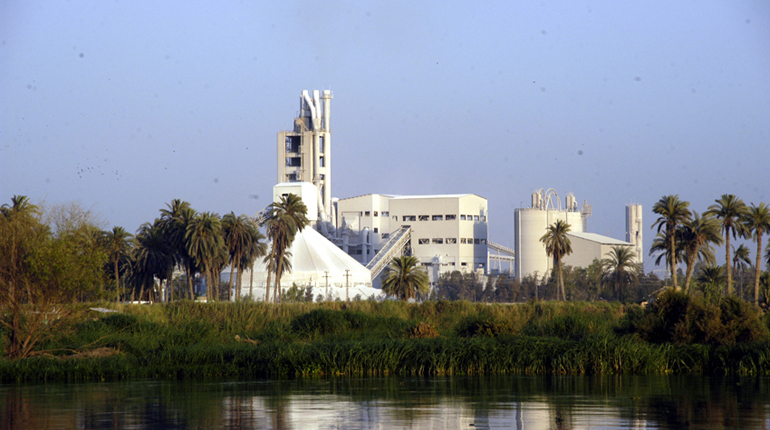 Suez Cement’s El Minya cement plant. EGAS is talking to industrial users to manage gas use. (Suez Cement)
Suez Cement’s El Minya cement plant. EGAS is talking to industrial users to manage gas use. (Suez Cement)
Egypt launched its long-anticipated tender for a third FSRU on Tuesday – in time to keep up with next year’s energy requirements and just before several major fields start production.
The tender will close in two weeks, and the new FSRU will enter operation in the second quarter of 2017, a ministry official told Interfax Natural Gas Daily.
The tender is for a vessel with a capacity of 21.24 million cubic metres per day (MMcm/d). It will be moored at a third, yet-to-be built pier at the Ain Sokhna port, where the first two FSRUs are located.
The third FSRU will lift Egypt’s LNG import capacity from 34 MMcm/d to 55.24 MMcm/d. Minister of Petroleum Tarek el-Molla told Egyptian media outlets the extra gas was intended for industrial users and power generation.
Egypt’s current LNG import capacity comes from a 14.6 MMcm/d vessel supplied by Norway’s Höegh in April 2015 and a 19.82 MMcm/d vessel provided by Singaporean company BW in September 2015.
Stopgap supplies
Egypt needs a gas supply stopgap before the start of production from Eni’s Zohr field and BP’s Atoll field at the end of next year as the country’s total output is falling while demand for gas is expected to rise sharply.
Ministry of Petroleum figures show that Egypt’s national gas production will reach up to 107.61 MMcm/d this year, down from 124.6 MMcm/d in 2015. They indicate a monthly decline of 2.83 MMcm per month.
The North Alex, Salamat, Atoll, West Delta Deep Marine and Zohr projects are expected to add 170 MMcm/d of production over the next five years, according to a petroleum ministry report seen by Interfax Natural Gas Daily.
The problem of declining output at Egypt’s fields is being compounded by rapidly rising demand.
The ministry report forecast that demand for both oil and gas will surge by 22% over the next five years as new fuel sources such as coal mitigate – but do not offset – industrial energy needs. The Ministry of Electricity plans to add 8 GW of generation capacity in 2016-2017 and another 13.9 GW in the following fiscal year. Large scale solar and nuclear power plants will not come online until the end of the decade at the earliest.
TAQA Arabia Executive Chairman Khaled Abu Bakr told Interfax Natural Gas Daily he expected a transition period of 4-5 years after Egypt’s domestic production begin to climb before the country can stop importing LNG.
He said the extra LNG imports were part of a broader movement from Egyptian Natural Gas Co. (EGAS) to be more accommodating with its customers – from ordering more LNG cargoes to shore up summer supply to asking large users to plan any routine closures for the peak summer months.
"[EGAS is] better at communicating with the consumers, so we [are seeing] more integrity [within the sector]," said Abu Bakr.
Making a saving
EGAS has already had to negotiate with industrial users this year to save gas where it can, which for some has been a welcome change from the arbitrary cuts they have seen for the past three years.
EGAS Chairman Mohamed al-Masry said in a statement this week that industrial supplies will not be cut during the peak summer month of August. Instead, he said the state company was "coordinating with some energy-intensive industries [to reduce] consumption by doing the work of the annual maintenance" during August, to offset an already significant jump in demand from the electricity sector.
The arrival of the summer peak period came early this year, causing power plant fuel consumption to shoot up to 115 MMcm/d in April as temperatures soared. Egyptian Electricity Holding Co. Chairman Gaber el-Desouky said in a statement a month ago that grid capacity was up to 32 GW after an emergency 3.6 GW upgrade in the spring, and that he anticipated peak demand over summer would be 31.5 GW.
An EGAS official, who asked to remain anonymous, told Interfax Natural Gas Daily that a total of 140 MMcm/d of both imported and domestically produced gas would be available over the summer months. The maximum amount of gas that could be given to the power sector without reducing supply to industrial customers was 108 MMcm/d.
EGAS has contracts with suppliers including Algeria’s Sonatrach, Russia’s Gazprom and Switzerland’s Vitol worth up to $3 billion to supply 80 LNG shipments this year at a cost of $300 million a month. It is in negotiations to import two more cargoes in the second half of this year.







Talk to us
Natural Gas Daily welcomes your comments. Email us at [email protected].